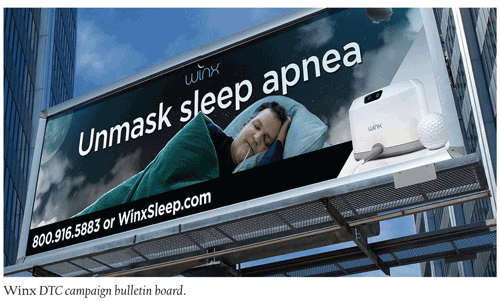Medical device marketers typically focus on the adoption of their products by healthcare professionals (HCPs). Often, patients are unaware of the devices HCPs use in their treatment, and sales success is dependent solely on HCP adoption. More recently, device manufacturers have been looking to engage patients to help drive demand and pull through sales. Certainly, this marketing practice is appropriate for elective surgical devices/products (e.g., the LAP-BAND System for weight reduction for patients with obesity, and Botox Cosmetic to temporarily improve the look of moderate to severe frown lines), but it’s now becoming more common for medical procedures (e.g., the Stryker GetAroundKnee System).
More and more medical device marketers are realizing the power of consumer demand to influence HCPs and help drive brand selection. That is why ApniCure, a medical device company focused on developing and commercializing novel home-use devices for the treatment of obstructive sleep apnea (OSA) and other sleep-related disorders, wanted to try a strategy geared towards patients. Working together, ApniCure and PulseCX piloted a highly targeted, measurable, multi-channel DTC campaign to raise patient awareness of their device and drive qualified leads to trained ENT surgeons.
The Product: ApniCure manufactures a medical device called Winx, which is designed for the 20 million people in the U.S. who suffer from OSA. This condition can be serious—it occurs when there are repeated episodes of complete or partial blockage of the upper airway during sleep. These episodes can interfere with sound sleep because men with OSA often wake up gasping for air. Because sufferers of OSA seldom get a “good night’s sleep,” OSA can result in sleepiness, poor productivity and absenteeism at work.
Winx is designed to offer certain benefits over the existing number one OSA treatment, which is a continuous positive airway pressure (CPAP) mask, but in bringing the device to the attention of patients and doctors, the company found it to be an uphill climb.
The Problem: For more than a decade, the number one treatment for OSA had been the proven effective CPAP mask. ApniCure needed to break through this access barrier, and it started by taking a look at the customer experience.
Although the CPAP mask was firmly entrenched as the number one OSA treatment, the device did have a few drawbacks—from a patient perspective—that marketers could capitalize on in forming the Winx campaign. The device is loud, cumbersome and uncomfortable to wear and prevents users from moving around freely when they sleep. Not only that, but according to many users, the mask itself is not “sexy.” All of this resulted in the noncompliance of more than 700,000 users within the first 12 months of use.
On the other hand, we pinpointed benefits that users experience when using the Winx rather than the CPAP mask. First, Winx users don’t have to wear a mask. Instead, they insert a custom-fit mouthpiece inside the mouth during sleep and breathe naturally through their nose. The device is also small, quiet, compact and easy-to-use—features that could potentially increase compliance among users.
The Challenge: Shift entrenched prescribing habits that have favored the market leader (CPAP) for more than a decade.
The Solution: It was determined that the most powerful way to position Winx was to offer a treatment experience that appeals to what customers desire most. This included designing a campaign that would deliver a brand experience that benefits both patients and HCPs.
First, it was important to discover the customers’ moments of truth. Identifying these key moments along the customer journey allowed us to recommend how to best influence the patient-physician dialog across all channels to begin forming a positive customer experience that would exert a strong influence on the patient-physician dialog.
To understand the connection between physicians and patients, in-depth patient journey research was conducted that uncovered key moments of truth when patients are fully engaged and motivated to change their behaviors. We discovered that patients with OSA are disengaged with the existing CPAP treatment because it’s difficult to use and uncomfortable. Our next step: Putting the Winx campaign together.
The Winx DTC Campaign: Putting It All Together
It was important to position Winx as the antithesis of the problematic CPAP mask. So, it was positioned to potential customers as the “new, nonsurgical, lifestyle-friendly treatment for sleep apnea.”
By incorporating imagery of peacefully sleeping customers—showing the small Winx console on their nightstand—ApniCure could now leverage the “visual” benefits of Winx through the “Unmask Apnea” advertising campaign.
Finally, we formulated a strategic roadmap that would maximize the impact of every DTC touch point. Each potential touch point was plotted along the customer journey, specific to both new and existing patients.
The Roll Out: Tactical executions included radio spots, banner ads, outdoor ads—and a website with a video product demonstration created to increase potential customers’ knowledge of OSA and the clear benefits of Winx.
Importantly, all tactics included a call to action for potential users to test the product for themselves at a sleep center located near their home—a sensory experience that could easily elevate product trial and usage.
The Results: The website created for ApniCure generated thousands of hits in just one week. Men were calling in by the hundreds to try Winx at local sleep centers and responding to the e-mails sent them to receive more information.
From the day it launched, the “Unmask Apnea” campaign awakened an audience that had trouble sleeping—and gave them a reason to try something new.





